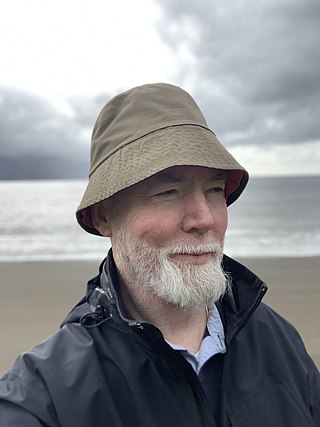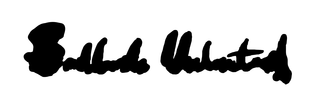Visual contributors
Most of the images in the book were generated from a process entitled "mindsourcing." [4] The manuscript was sent to 35 artists, from all over the world, some born after 1989, several born before 1945, who were asked to respond with relevant visual work.
They are Farah Al Qasimi, Ed Atkins, Gabriele Basilico, Alessandro Bava, Josh Bitelli, James Bridle, Cao Fei, Alex Mackin Dolan, Thomas Dozol, Constant Dullaart, Cécile B. Evans, Rami Farook, Hans-Peter Feldmann, GCC, Liam Gillick, Dominique Gonzalez-Foerster, Eloise Hawser, Camille Henrot, Hu Fang, K-Hole, Koo Jeong-A, Katja Novitskova, Lara Ogel, Trevor Paglen, Yuri Pattison, Jon Rafman, Bunny Rogers, Bogosi Sekhukhuni, Taryn Simon, Hito Steyerl, Michael Stipe, Rosemarie Trockel, Amalia Ulman, David Weir and Trevor Yeung.

Herbert Marshall McLuhan was a Canadian philosopher whose work is among the cornerstones of the study of media theory. He studied at the University of Manitoba and the University of Cambridge. He began his teaching career as a professor of English at several universities in the United States and Canada before moving to the University of Toronto in 1946, where he remained for the rest of his life. He is known as the "father of media studies".
Media ecology theory is the study of media, technology, and communication and how they affect human environments. The theoretical concepts were proposed by Marshall McLuhan in 1964, while the term media ecology was first formally introduced by Neil Postman in 1968.

The Medium is the Massage: An Inventory of Effects is a book co-created by media analyst Marshall McLuhan and graphic designer Quentin Fiore, with coordination by Jerome Agel. It was published by Bantam Books in 1967 and became a bestseller with a cult following. The U.K. edition was published by Allen Lane Penguin Books using cover art by Newsweek photographer Tony Rollo.

Hans Ulrich Obrist is a Swiss art curator, critic, and art historian. He is artistic director at the Serpentine Galleries, London. Obrist is the author of The Interview Project, an extensive ongoing project of interviews. He is also co-editor of the Cahiers d'Art review. He lives and works in London.
Bidoun is a non-profit organization focused on art and culture from the Middle East and its diasporas. Bidoun was founded as a print publication and magazine in 2004 by Lisa Farjam, eventually expanding to online publishing and curatorial projects. The print edition of the magazine was in publication from spring 2004 until spring 2013.
Madelon Vriesendorp is a Dutch artist, painter, sculptor and art collector. She was married to Rem Koolhaas and best known as one of the co-founders of the Office of Metropolitan Architecture (OMA) in the early 1970s. Vriesendorp would often create visuals and graphics for OMA in the early years.
This is a bibliography of Marshall McLuhan's works.

Douglas Coupland is a Canadian novelist, designer, and visual artist. His first novel, the 1991 international bestseller Generation X: Tales for an Accelerated Culture, popularized the terms Generation X and McJob. He has published 13 novels, two collections of short stories, seven non-fiction books, and a number of dramatic works and screenplays for film and television. He is a columnist for the Financial Times, as well as a frequent contributor to The New York Times, e-flux journal, DIS Magazine, and Vice. His art exhibits include Everywhere Is Anywhere Is Anything Is Everything, which was exhibited at the Vancouver Art Gallery, and the Royal Ontario Museum and the Museum of Contemporary Canadian Art, now the Museum of Contemporary Art Toronto Canada, and Bit Rot at Rotterdam's Witte de With Center for Contemporary Art, as well as the Villa Stuck.
Quentin Fiore was a graphic designer, who worked mostly in books.

Roger Hiorns is a British artist based in London. His primary media is sculpture and installation, using a wide variety of materials, including metals, wood and plastics. He also works in the media of video and photography.
Laboratorium was a contemporary art exhibition curated by Barbara Vanderlinden and Hans-Ulrich Obrist at Fotomuseum Antwerp, the Century City building and various other locations in Antwerp, Belgium, from 27 June to 3 October 1999.

Badlands Unlimited was a New York-based independent publisher founded by the artist Paul Chan in 2010. The press published texts by and with other artists in the form of paperbacks, ebooks, digital group exhibitions, a stone book, and other various media. The press also consulted on projects related to digital publishing for art institutions. As of late 2019, Badlands Unlimited has "closed for good". Badlands books have been featured and reviewed in the New York Times, New York Review of Books, Bookforum, Publishers Weekly, and Vogue, among many other publications.
Shumon Basar is a British writer, editor and curator.
Daina Augaitis is a Canadian curator whose work focuses on contemporary art. From 1996 to 2017, she was the chief curator and associate director of the Vancouver Art Gallery in British Columbia.

Art Dubai is an international art fair that takes place every March in Dubai. Founded in 2007, Art Dubai is a major platform for art from the Middle East, North Africa and South Asia. Each year, the fair features a globally diverse lineup of over 90 galleries from more than 40 different countries,
This is a bibliography for Hans-Ulrich Obrist, a Swiss art curator, critic and historian of art. He currently lives in London.
Joseph Grigely is an American visual artist and scholar. His work is primarily conceptual and engages a variety of media forms including sculpture, video, and installations. Grigely was included in two Whitney Biennials, and is also a Guggenheim Fellow. He lives and works in Chicago, where he is Professor of Visual and Critical Studies at the School of the Art Institute of Chicago.
Simon Castets is a French-American curator serving as the Director of Strategic Initiatives of LUMA Arles, France since 2022. From 2013 to 2021, he was Director of Swiss Institute Contemporary Art New York, then its Executive Chair through 2022, and continues to serve on its Board as a Trustee.

The Nineties: A Book is a 2022 book by Chuck Klosterman. It is an analysis of historical trends and pop culture phenomena in the decade of the 1990s. It was released February 8, 2022, by Penguin Books. It debuted at No. 2 on The New York Times nonfiction bestseller list on February 27, 2022.

The Medium Is the Massage is an album by Canadian media philosopher Marshall McLuhan, released in July 1967 by Columbia Records. It is the audio companion to the book of the same name, co-authored by McLuhan with Quentin Fiore, which explores the subconscious effects of mass media on the global psyche. The record was produced by John Simon of Columbia, who took creative control of the recording, and co-ordinated by Jerome Agel.









